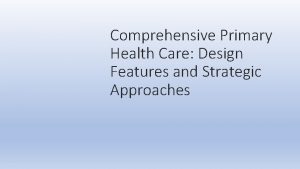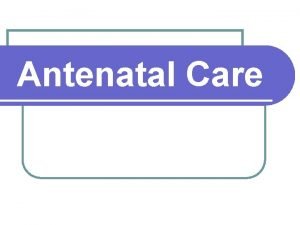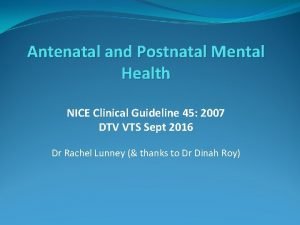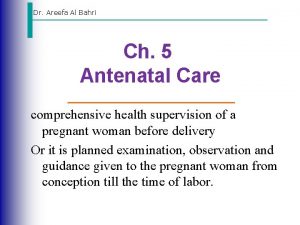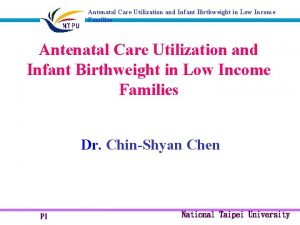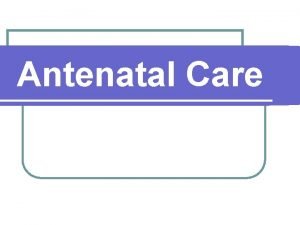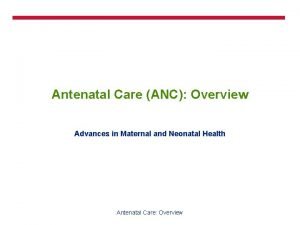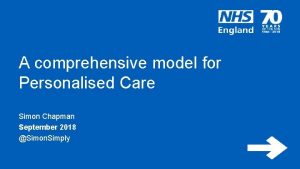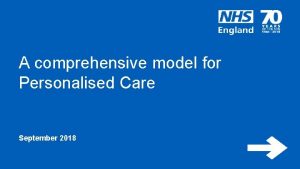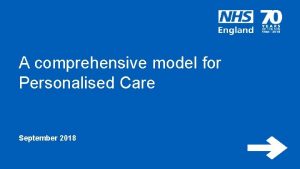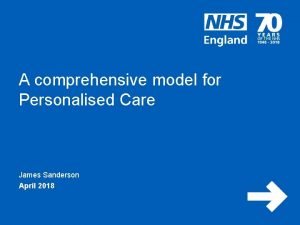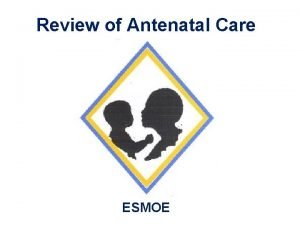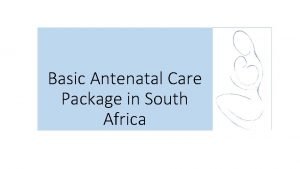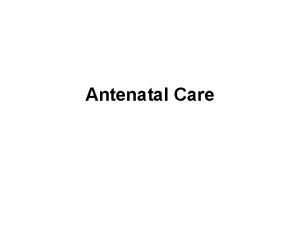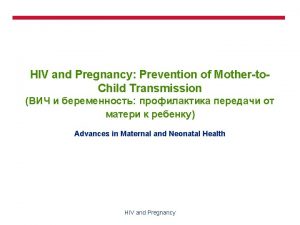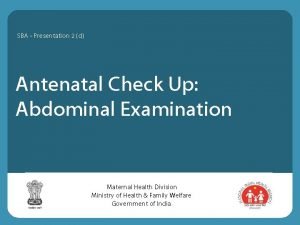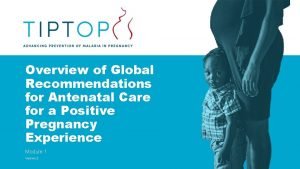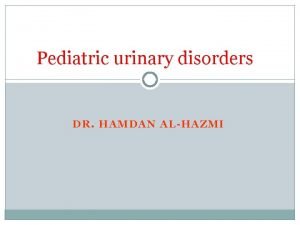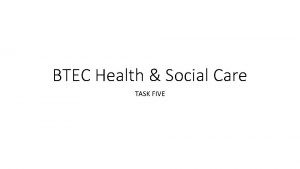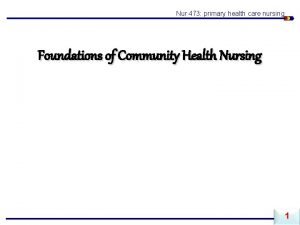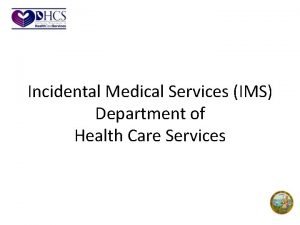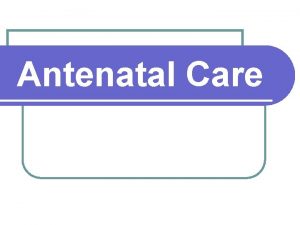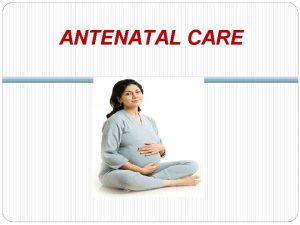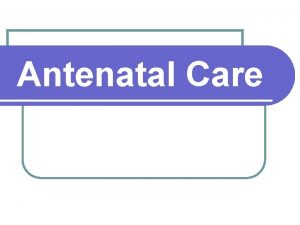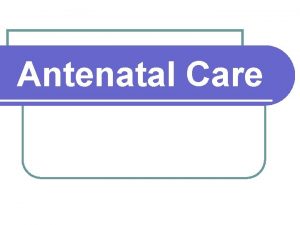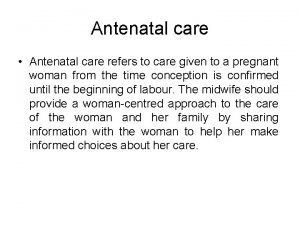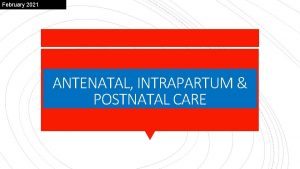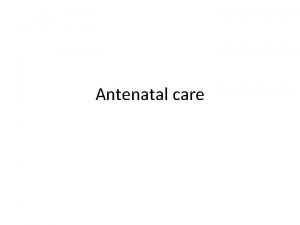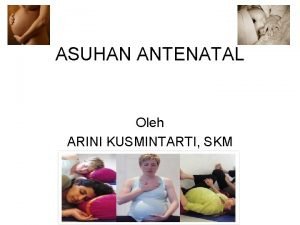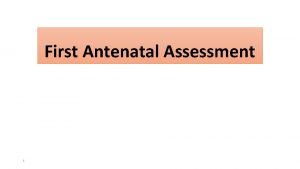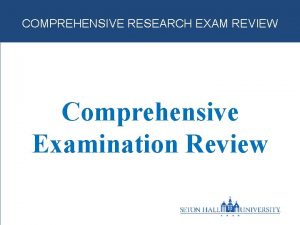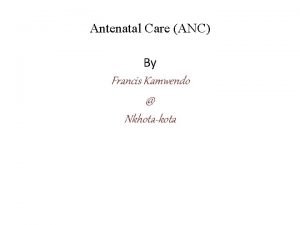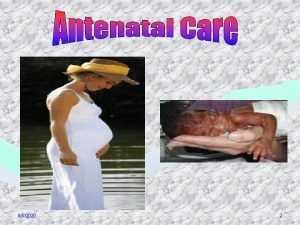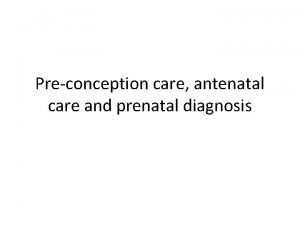Antenatal Care Definition of Antenatal care comprehensive health

































- Slides: 33

Antenatal Care

Definition of Antenatal care comprehensive health supervision of a pregnant woman before delivery Or it is planned examination, observation and guidance given to the pregnant woman from conception till the time of labor.

Goals l To reduce maternal and perinatal mortality and morbidity rates l To improve the physical and mental health of women and children

Importance of Antenatal Care l To ensure that the pregnant woman and her fetus are in the best possible health. l To detect early and treat properly complications l l Offering education for parenthood To prepare the woman for labor, lactation and care of her infant

Schedule for Antenatal Visits: The first visit or initial visit should be made as early is pregnancy as possible. Return Visits: l Once every month till 7 th month. l Once every 2 weeks till the 9 th month l Once every week during the 9 th month, till labor.

Assessment History Examination Investigation

History l Personal history l Family history l Medical and surgical history l Menstrual history l Obstetrical history l History of present pregnancy

Physical Examinations l Height of over 150 cm indication of an average-sized pelvis l The approximate weight gain during pregnancy is 12 kg. ; 2 kg in the first 20 weeks and 10 kg in the remaining 20 weeks (1. 5 kg per week until term).

l Obesity (more than 20 kg above the weight-height formula) leads to an increased risk of gestational diabetes, pregnancy-induced hypertension and thrombo-embolic disorders

Local Examination The uterus may be higher than expected due to large fetus, multiple pregnancy, polyhydrammnios or mistaken date of last menstrual period. l The uterus may be lower than expected due to small fetus, intrauterine growth retardation, oligohydramnios or mistaken date of last menstrual period. l

l Fetal heart sound is heard by sonicaid as early as 10 thweek of pregnancy. l Fetal heart sound is heard by Pinard' s fetal stethoscope after the 20 thweek of pregnancy. l The normal fetal heart rate is 120 -160 beats/min

Investigations: l Urine should be tested for sugar, ketones and protein. l Hemoglobin will be repeated: l At 36 weeks of gestation. l Every 4 weeks if Hb is < 9 g/dl.

Fetal kick count l The pregnant woman reports at least 10 movements in 12 hours. l Absence of fetal movements precedes intrauterine fetal death by 48 hours.

Health Teaching during the First Trimester l l l Physiological changes during pregnancy Weight gain Fresh air and sunshine Rest and sleep Diet Daily activities Exercises and relaxation Hygiene Teeth Bladder and bowel Sexual counseling l l l l l Smoking : Medications Infection Irradiation Occupational and environmental hazards Travel Follow up Minor discomforts Signs of Potential Complications

Exercise should be simple, mild exercise avoid lifting heavy weights l A tooth can be extracted during pregnancy, but local analgesia is recommended l Catheter and enema should be avoided. l Smoking may lead to ptyalism, nervousness and hyper emesis and make pregnant woman at increased risk of chest infections and thrombo-embolic disorders l

l Pregnant woman should avoid contact with infectious diseases especially rubella or (German measles) because it has deleterious effects on the fetus l Pregnant woman should avoid exposure to x- ray or irradiation because of possible teratogenic effects on the fetus such as birth defects or childhood leukemia

Common Discomforts of Pregnancy, Etiology, and Relief Measures : Urinary frequency RELIEF MEASURES: l l l Decrease fluid intake at night. Maintain fluid intake during day. Void when feel the urge.

Fatigue RELIEF MEASURES: l Rest frequency. l Go to bed earlier.

Sleep difficulties RELIEF MEASURES: l Rest frequency l Decrease fluid intake at night

Breast enlargement and sensitivity RELIEF MEASURES: Wear a good supporting bra. l Assess for other conditions. l

Nasal stuffiness and epistaxis ETIOLGY: Elevated estrogen levels l RELIEF MEASURES : l Avoid decongestants. l Use humidifiers, and normal saline drops.

Ptyalism (excessive salivation) ETIOLGY: Unknown RELIEF MEASURES: l. Perform frequent mouth care. l. Chew gum. l. Decrease fluid intake at night. l. Maintain fluid intake during day.

Nausea and vomiting l RELIEF MEASURES: l Avoid food or smells that exacerbate condition. l Eat dry crackers or toast before rising in morning. l Eat small, frequent meals. l Avoid sudden movements. Get out of bed slowly l Breath fresh air to help relieve nausea.

Shortness of breath l RELIEF MEASURES: l Use extra pillows at night to keep more upright. l Limit activity during day

Heartburn RELIEF MEASURES: Eat small, more frequent meals. l Use antacids. l Avoid overeating and spicy foods. l

Dependent edema l l l Avoid standing for long periods. Elevate legs when laying or sitting. Avoid tight stockings.

Varicosities l l l Rest in sims' position. Elevate legs regularly. Avoid crossing legs. Avoid tight stockings. Avoid long periods of standing

Hemorrhoids RELIEF MEASURES: l. Maintain regular bowel habits. l. Use prescribed stool softeners. l. Apply topical or anesthetic ointments to area.

Constipation RELIEF MEASURES: l. Maintain regular bowel habits. l. Increase fiber in diet. l. Increase fluids. l. Find iron preparation that is least constipating

Leucorrhea RELIEF MEASURES: l. Take a daily bath or shower. l. Wear cotton underwear.

Backache RELIEF MEASURES: l. Wear shoes with low heels. l. Walk with pelvis tilted forward. l. Use firmer mattress. l. Perform pelvic rocking or tilting

Leg cramps l RELIEF MEASURES: Extend affected leg and dorsiflex the foot. l Elevate lower legs frequently. l Apply heat to muscles. l Evaluate diet. l

Faintness RELIEF MEASURES: • Rise slowly from sitting to standing. • Evaluate hemoglobin and hematocrit. • Avoid hot environments
 Comprehensive primary health care approach
Comprehensive primary health care approach Definition of antenatal care
Definition of antenatal care Antenatal care definition
Antenatal care definition Nice antenatal and postnatal mental health
Nice antenatal and postnatal mental health Site:slidetodoc.com
Site:slidetodoc.com Conclusion on antenatal care
Conclusion on antenatal care Importance of antenatal care
Importance of antenatal care Summary of antenatal care
Summary of antenatal care Comprehensive care plan
Comprehensive care plan Comprehensive model of personalised care
Comprehensive model of personalised care Comprehensive model of personalised care
Comprehensive model of personalised care Personalised care operating model
Personalised care operating model Comprehensive model of personalised care
Comprehensive model of personalised care Health and social component 3
Health and social component 3 Health and social care values unit 2
Health and social care values unit 2 Antenatal card
Antenatal card Antenatal class adalah
Antenatal class adalah Banc plus 2019
Banc plus 2019 Antenatal visit
Antenatal visit Antenatal intrapartum and postnatal
Antenatal intrapartum and postnatal Leopold maneuvers
Leopold maneuvers 3 weeks pregnant ultrasound
3 weeks pregnant ultrasound Mcug
Mcug Comprehensive research definition
Comprehensive research definition Primary secondary and tertiary care
Primary secondary and tertiary care Health care system definition
Health care system definition Health care system definition
Health care system definition Intellectual definition health and social care
Intellectual definition health and social care Home health care definition
Home health care definition Designation of health care surrogate definition
Designation of health care surrogate definition Transcultural health care definition
Transcultural health care definition Public health terminology
Public health terminology Primary health care principles
Primary health care principles Definition of primary health care services
Definition of primary health care services
